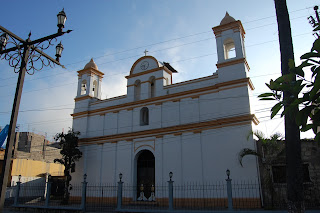I attended the three-day Conference on Honduras held at Copán Ruinas last week. Those attending from AHMEN also included Tom Camp, Michael Franklin, Doris and Brent Brady and Byron Morales. Although I had been in Honduras quite a few times over the past several years, this was the first time I had the opportunity to meet so many people working for the betterment of the people of Honduras. I have been in the town of Copán Ruinas before, but never long enough to really enjoy what this town has to offer. I was truly impressed.
 |
| Mayan Ball Field |
The small town is located in the mountainous northwest of Honduras some ten miles from the border with Guatemala. The town is built around a beautiful central plaza bordered by a large church, municipal buildings, shop and hotels. The Spanish influence is obvious in the architecture, but the flavor is Honduran. There is a predominant Mayan population, with storefront signage in both Spanish and sometimes Mayan. The clean, narrow streets are cobbled with large stones and bordered with narrow sidewalks. Situated on a hillside, the only flat area is near the central Plaza. Most residents walk but there are lots of three wheeled taxies scurrying along the one-way streets.
 |
| Church on the Central Plaza |
Tourism plays a major economic role in Copán. One of the finest areas of Mayan ruins is located less than a mile from the Plaza. The ruins are beautiful and half-day tour and exploration should never be missed. A visit to Macaw Mountain is also a good idea. The Copán’s narrow streets are full, but not crowded with, local people selling crafts and local food. Hand made jewelry of jade and other semiprecious stones; weavings, embroidery, stone carvings and leather goods fill tables centered near the plaza. I felt little pressure to buy, and browsing is encouraged. There are restaurants to suit any taste and price, from gourmet to tipico. We stayed in a small hotel just off the Plaza. It was clean and comfortable.
 |
| Mayan Traditional Garb on Sundays for Church |
Coffee shops open at 6AM as the town awakens to people walking to their jobs, or compesinos waiting to catch a ride to the coffee plantations. Everyone offers “Buenos Dias”, or just “Buenos….”.
The Conference was held at the Clarion Hotel just outside town near the ruins. An impressive facility, many attendees stayed there. There were speakers on many topics dealing with everything from educational issues, healthcare, security and orphanages, to economic resources, and entrepreneurism to government assistance for volunteerism.
The U.S. Ambassador to Honduras spoke, as did representatives of the U.N., USAID, and the Honduras Congress. There were speakers from many NGOs, mission groups, and other entities, secular and non-secular. Most participants represented concerns in the central area of the country. There was little representation from Colón and even less from Gracias a Dios except by the AHMEN cadre. AHMEN had the largest presence of any group attending and we made our presence known.
The U.S. Ambassador to Honduras spoke, as did representatives of the U.N., USAID, and the Honduras Congress. There were speakers from many NGOs, mission groups, and other entities, secular and non-secular. Most participants represented concerns in the central area of the country. There was little representation from Colón and even less from Gracias a Dios except by the AHMEN cadre. AHMEN had the largest presence of any group attending and we made our presence known.
 |
| Francisco Morazán |
Presentations were limited to 15 minutes and were grouped by subject matter as in healthcare, education etc. There Q&A sessions after the completion of each sector. Presentations were delivered in either English or Spanish with real-time translation via radio earpieces. Computer projectors displayed PowerPoints to the room and to the overflow in a separate dining room nearby. The quality of the presentation was excellent. A large component of the meeting, and it’s stated goal and purpose, was to encourage networking between the attendees. Plenty of break time and meet-and- greets were encouraged. Socializing was encouraged and these times were used for networking and making contacts with people with similar interests.









No comments:
Post a Comment